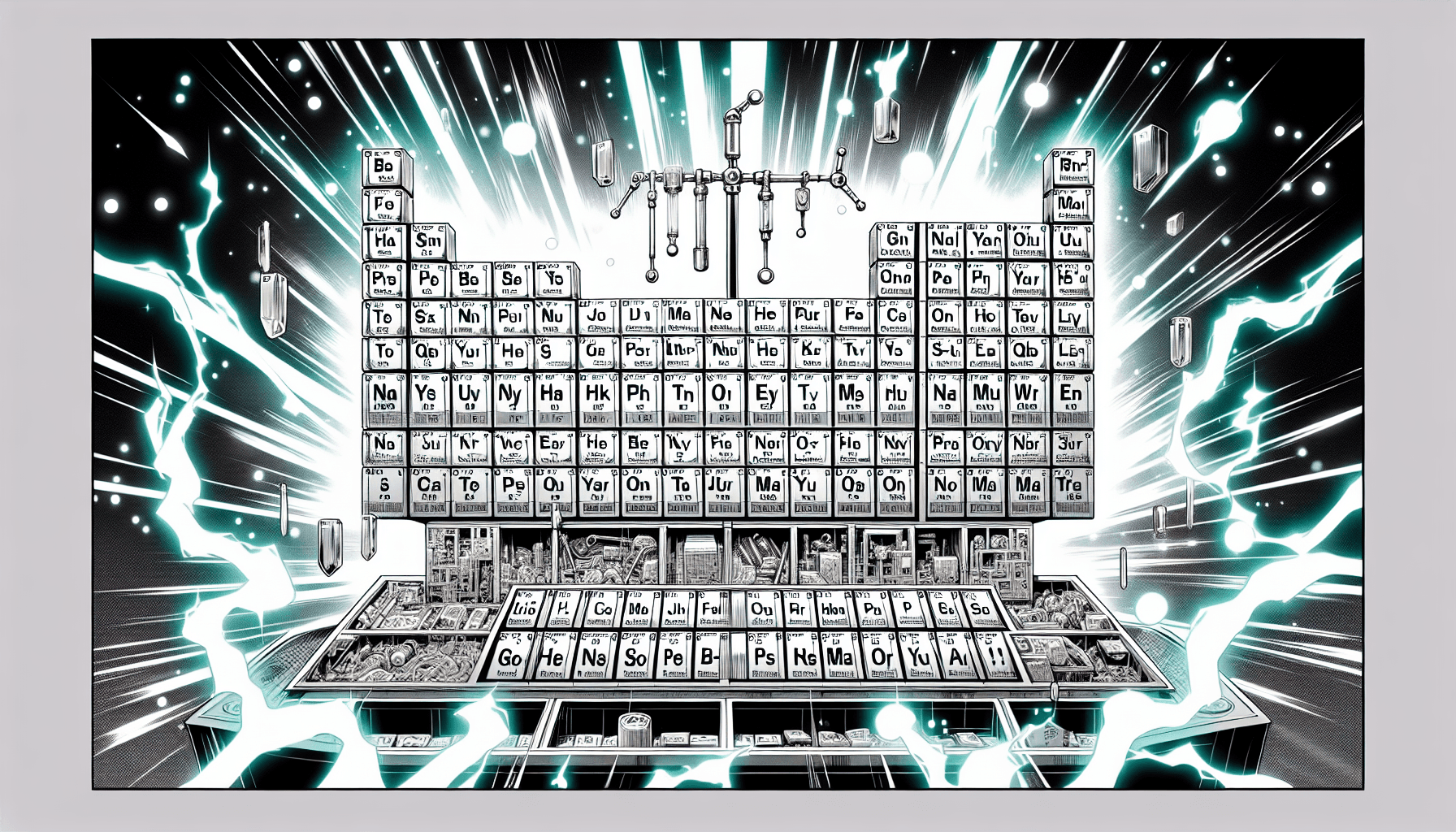Today in Edworking News we want to talk about The Periodic Table of the Elements, in Pictures and Words
This pictorial periodic table is colorful, fun, and packed with information. In addition to the element's name, symbol, and atomic number, each element box has a drawing of one of the element's main human uses or natural occurrences. The table is color-coded to show the chemical groupings. Small symbols pack in additional information: solid/liquid/gas, color of element, common in the human body, common in the earth's crust, magnetic metals, noble metals, radioactive, and rare or never found in nature. It does not overload kids with a lot of detailed numbers, like atomic weights and valence numbers.
 Interactive Periodic Table of the Elements
Interactive Periodic Table of the Elements

Note: Elements in Pictures and Elements in Words are a set. Either may stand alone, but they work best together. This contains most of the same information on an interactive web page. See also: Links to translations in other languages.
 The Textual Periodic Table
The Textual Periodic Table
The textual periodic table is packed with even more information. In addition to the element's name, symbol, and atomic number, each element box contains a textual description of the element's physical properties and a list of several of its human uses and/or natural occurrences. The table is color-coded to show the chemical groups, and each group is described in a panel of the same color. Other info panels describe atomic structure, chemical bonding, and radioactivity. It does not overload kids with a lot of detailed numbers, but it does provide some simple rules-of-thumb about atomic weights and valence numbers.
See also: The Elements — Descriptions, Uses and Occurrences
This contains most of the same information, but in a less graphical, more textual html format. It also contains handy links to search for more info about each use. This has both Elements in Pictures and Elements in Words combined on a single page. This contains most of the same information on an interactive web page. This is exactly the same as Elements in Pictures above, but with less information. The fine print — the legend boxes and the small symbols — have been removed. Use this if you want a cleaner image with less visual clutter, or you want less information, or you want to print smaller or at lower resolution.
 Print-Your-Own Elements Cards
Print-Your-Own Elements Cards
Print-your-own elements cards. Use these however you want. It's fun to simply lay them out to make the whole periodic table. You can use them as flash cards to help you memorize the facts on the front and back of each card. If you want to play it as a game, you can invent your own game rules. Print double-sided on card stock. Cut out cards with paper cutter or scissors. Nine cards per sheet. There's a card for every element, with a picture on the front and words on the back. Also included are key cards (symbol key and color key), info cards (atom info and bonding info), and group info cards. The zip file also includes a template for making a card box. It also includes printing instructions. Sorry, card decks are not for sale at the Wlonk Shop. You need to print them yourself. See Links for cards at other shops.
 Large Format and Worksheets
Large Format and Worksheets
Print each element on a separate sheet. You can make a very large periodic table to cover a large wall. Or you can use the sheets separately, for example, each student chooses one element. Print single-sided. Elements 1-98 have pictures. Also included are key sheets (symbol key and color key), info sheets (atom info and bonding info), and group info sheets. Sorry, elements sheets are not for sale at the Wlonk Shop. You need to print them yourself.
Printable student worksheet. Print one or many per student. This worksheet has spaces for the student to write the element's symbol, name, atomic number, description, uses and/or occurrences, and a space to draw a picture. Are you homeschooling? This activity can occupy your student for one or many days. If you want a big activity, print out 98 of these worksheets, and assign your student to research every element from 1 to 98 (the elements with uses) and fill out a worksheet for each element, one or a few elements per day. This is not just busywork; knowing some facts about each element is useful basic knowledge for many careers: engineering, manufacturing, biology, medicine, ecology, agriculture, geology, physics, and, of course, chemistry!
Edworking is the best and smartest decision for SMEs and startups to be more productive. Edworking is a FREE superapp of productivity that includes all you need for work powered by AI in the same superapp, connecting Task Management, Docs, Chat, Videocall, and File Management. Save money today by not paying for Slack, Trello, Dropbox, Zoom, and Notion.

 Alternative Periodic Tables
Alternative Periodic Tables
Students will have fun building paper models of all these alternative periodic tables. Then they can discuss how the models are different and yet the same. This left-step periodic table is the basis for the spiral, cone, and cylinder models. This left-step table is a slightly modified version of the left-step table by Charles Janet (1928). This compact version places hydrogen, helium, lithium, and beryllium all in a single row. Note that hydrogen is unique — it may be grouped with the alkali metals (like lithium) because it has one electron available to donate, grouped with the halogens (like fluorine) because gaining one electron will fill its valence shell, or it may be put in a group of its own.
 3D Visualizations and Atomic Orbitals
3D Visualizations and Atomic Orbitals
In this periodic table, the elements are arranged in a single flat spiral (not concentric circles). In this model, the elements are arranged in a single conical spiral (not stacked rings). The paper model above is very easy to make. The more elaborate paper-and-plastic model below is more difficult to make. In this model, the elements are arranged in a single cylindrical helix (not stacked rings). The paper model above is very easy to make. The more elaborate paper-and-plastic model below is more difficult to make.
Atomic Orbitals (Color) This color-coded chart shows what atoms look like. This chart shows all the fundamental atomic electron orbitals as electron probability density distributions (fuzzy clouds), which is as close as you can get to visualizing what an atom really looks like. The orbitals are labeled. It describes other ways to visualize atoms, namely, electron orbits (like planets) and surfaces of constant probability (bulgy blobs). It has a small periodic table showing in which order the electron shells are filled.
Atomic Orbitals (Black) This white-on-black chart shows what atoms look like. This chart shows all the fundamental atomic electron orbitals as electron probability density distributions (fuzzy clouds), which is as close as you can get to visualizing what an atom really looks like. The orbitals are labeled. This elegant chart has little visual clutter. See other websites for 3D visualizations. See Links for 3D products.

 Particle Physics
Particle Physics
Particles (Standard Model) This chart shows what the universe is made of. This chart shows all the elementary particles in the standard model (SM) of particle physics, and many non-elementary particles too. It starts with the basics: an atom contains a nucleus of protons and neutrons, which are made of quarks. The chart organizes all the important particles and classes of particles: elementary fermions (quarks, leptons, electrons, neutrinos), elementary bosons (gluons, photons, W and Z bosons, Higgs, and predicted gravitons), composite particles (hadrons, baryons, protons, neutrons, mesons), anti-particles. This chart does not show the many predicted supersymmetry particles.
Particles (Standard Model + Supersymmetry) This chart shows what the universe is made of. This chart shows all the elementary particles in the standard model (SM) of particle physics, plus the many predicted supersymmetry (SUSY) particles. Many physicists think supersymmetry is likely to exist, and many physicists do not. Note: In the coming years, physicists may discover new particles or significantly revise the standard model of particle physics, due to new experimental results from colliders, such as the Large Hadron Collider (LHC), and new observations from telescopes.
 Reference Information
Reference Information
IUPAC is the world authority on the naming of elements.
Remember these 3 key ideas for your startup:
- Engagement is key: Use visual tools like the pictorial periodic table to make educational content more engaging and memorable. Incorporating visuals can make complex information more accessible, a useful strategy for marketing your products or services.
- Adaptability: Customize resources like the periodic table cards to fit your needs. Flexibility and customization can enhance your product offerings, making them suitable for a broader audience or specific client needs.Educational Impact: Activities like building paper models or engaging with interactive tools can be applied to product development or client engagement strategies. This kind of hands-on approach fosters better understanding and retention, which can be applied to training or workshop settings within your startup.

Edworking is the best and smartest decision for SMEs and startups to be more productive. Edworking is a FREE superapp of productivity that includes all you need for work powered by AI in the same superapp, connecting Task Management, Docs, Chat, Videocall, and File Management. Save money today by not paying for Slack, Trello, Dropbox, Zoom, and Notion.
Ready to transform your startup's approach to teamwork and productivity? Check out Edworking now!
For more details, see the original source.






